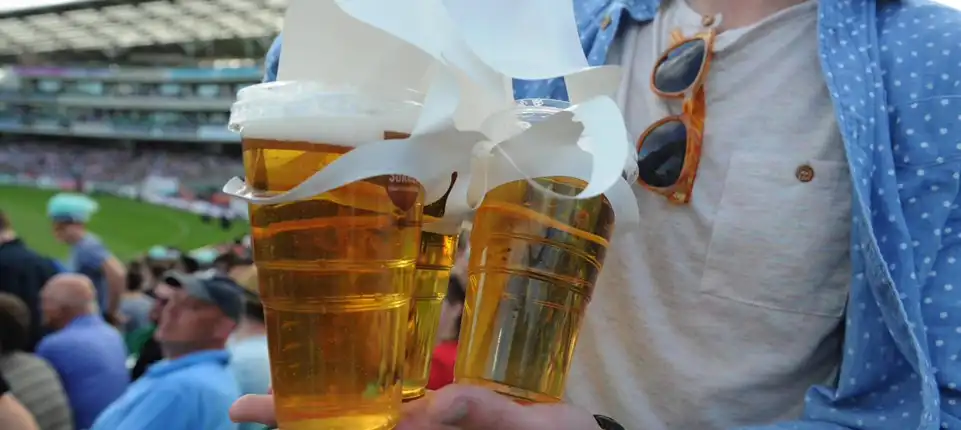May 22, 2019
Alcohol and sport – a potent mix

With the NRL and AFL seasons now underway, it’s a timely opportunity to explore the complex relationship between alcohol and sport.
As the seasons unfold, people will be getting together to cheer their teams on at home or in public spaces. Many will also share alcoholic drinks. It’s an atmosphere of comradery and competition that is so familiar to many Australians - but it can also increase risks to health and wellbeing.
Alcohol and the aggressive supporter
Emerging research is highlighting the potential of sport and alcohol to fuel aggressive behaviour among fans.1
When people attend sporting matches, like soccer or AFL games, it is common for fans to take a strong stance in support of their team. This connection bonds them to fellow supporters, but it can also boost their aggressive attitude towards rival teams.
Globally, it is known that violent behaviour among sports fans has led to injury, and even death, following a sports event. Although there is mixed evidence, there is now a focus on better understanding the links that this violence might have to alcohol.1
Australia is not immune to these potential harms, with documented violence among fans in various sports.1 Although the level of harm is not as high as other countries, it is important to acknowledge the additional risk alcohol brings to an already tense social atmosphere.
Link to domestic violence
Recent research has shown that there is a clear link between increased domestic violence incidents and the State of Origin rugby competition in New South Wales and Queensland.2
Researchers compared domestic violence statistics over the course of the State of Origin matches in NSW and Queensland to the same statistics in Victoria, where these matches are less popular.
This research found a 40% increase in domestic assaults and a 70% increase in non-domestic assaults in NSW and Queensland. This is significant when compared to Victoria, which saw no increase in the same time period.2
We also know that alcohol plays a significant role in domestic violence generally.
The excessive drinking that occurs during major sporting events is contributing additional risks to partners and families experiencing verbal and physical assault during these times.
Alcohol advertising and young people
In Australia, legislation states that alcohol advertising on television cannot occur during children’s viewing times. The exception is during sporting events, such as rugby, cricket or AFL seasons.
This means that if children are watching a sporting event between 5am and 8.30pm, they will be exposed to alcohol advertising.3,4
Research shows that when children and young people are exposed to alcohol advertising, they are more likely to start drinking earlier.3,4
We know that when young people start drinking at an early age and binge drink, this may lead to adoption of unhealthy drinking habits in the future.
This is particularly true for young people with a lack of family and community support around them to support them.5 Exposure to alcohol advertising during sporting events could, therefore, exacerbate the risk factors for young people.
Preventing the harms
As the NRL and AFL seasons unfold, there is an opportunity to consider what we can do as a community to prevent the harms associated with alcohol and sport.
Alongside larger scale approaches, such as the Alcohol and Drug Foundation’s Good Sports program, it is also important for people to have clear information regarding alcohol use. The National Guidelines recommend:
- drinking no more than 2 standard drinks per day with at least one day alcohol free per week
• having no more than 4 standard drinks per occasion
• not drinking while trying to conceive or if you are already pregnant
• delaying initiation into drinking alcohol until after 18 years of age.6
It can be difficult to understand what a standard drink actually looks like, and how different types of alcohol measure up when you are at a social event.
More Information
- Help & Support
- Call the National Alcohol and Other Drug Hotline on 1800 250 015 for free and confidential advice, information and counselling about alcohol and other drugs
- 1800 RESPECT National Sexual Assault, Domestic Family Violence Counselling Service:
1800 737 732
- Ostrowsky, M. K. (2018). Sports Fans, Alcohol Use, and Violent Behavior: A Sociological Review. Trauma, Violence and Abuse, 19(4), 406-419.
- Livingston, M. (2018, October 10). Foundation for Alcohol and Education.
- Carr, S., O'Brien, K. S., Ferris, J., Room, R., Livingston, M., Vandenberg, B., . . . Lynott, D. (2015). Child and adolescent exposure to alcohol advertising in Australia's major televised sports. Drug and Alcohol Review, 35(4).
- O'Brien, K. S., Carr, S., Ferris, J., Room, R., Miller, P., Livingston, M., . . . Lynott, D. (2015). Alcohol Advertising in Sport and Non-Sport TV in Australia, during Children's Viewing Times. PLOS ONE, 10(8), 1-9.
- Loxley, W., Toumbourou, J. W., Stockwell, T., Haines, B., Scott, K., Godfrey, C., . . . Williams, J. (2004). The Prevention of Substance Use, Risk, and Harm in Australia: a review of the evidence. Canberra: Australian Government Department of Health and Ageing.
- National Health and Medical Research Council (NHMRC). (2009). Australian Guidelines to Reduce Health Risks from Drinking Alcohol. Canberra: NHMRC.


